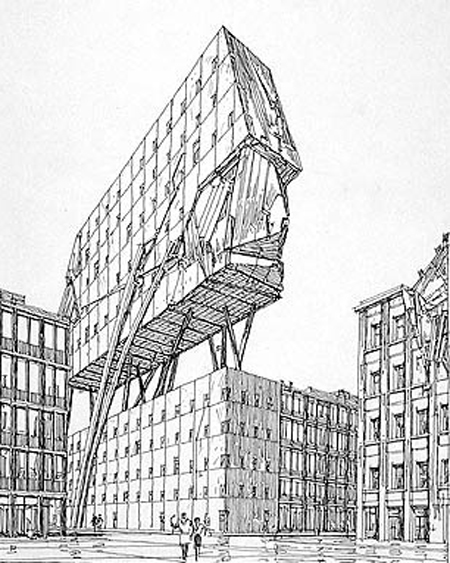
Here we have Lebbeus Woods, who “continues to work at a small drafting table in a corner of his apartment here, a solitary, monklike figure churning out increasingly abstract architectural fantasies…”
Would someone please get this man a Second Life account?
He even has a show running at MoMA called ‘Dreamland’ (not to be confused with Anshe Chung’s virtual ‘Dreamland‘ empire in Second Life).
If ever there was an architect who’s work would benefit from virtual immersion, it is Lebbeus Woods. His sketches are brilliant, and will always hold an important post in architectural expression, but they are just so many static portals into his imagination. Wouldn’t it be better if the rest of the world could walk inside living, breathing, holistic creations in a virtual environment instead of traveling to MoMA to see sketches?
We have seen several projects within Second Life that have this kind of ‘shake-up’ potential to challenge the status quo, and even some outward facing projects that challenge real life architectural norms. But they’re still essentially off the industry radar, with very little uptake in mainstream discussion or education. There is no doubt in my mind that native architectural talent already immersed in Second Life has the skill and wherewithal to achieve such great heights, but how and when will their work be counted amongst the industry’s FIC? Will it ever be? Should it be?
In my humble opinion, the vast, amorphous, virtual fabric of the Second Life grid itself is already worthy of inclusion and consideration as one of the most significant architectural achievements of our time. The profound, the abstract, the literal, the silly, the corporate, the preposterous, the serious…the whole thing, every prim of it, ought to be considered a magnificent architectural manifestation on par with even the most recognized theoretical inventions. To be sure, Second Life is the greatest singular manifestation of free, creative architectural expression the world has ever seen. Yet it remains all but ignored by our profession.
When will architectural giants of theory see the low hanging fruit of virtual environments as a tool for enabling people from around the world to more fully experience their ideas in an immersive and holistic fashion than sketches and illustrations offer? Will they ever? Or will it have to be born from within? It seems increasingly clear to me that the architectural greats of tomorrow’s serious theory might not come from hallowed halls, but from avatars, and communities of avatars operating in virtual environments- not starchitects or solitary monklike figures.
Here are some other ‘food-for-thought’ quotes from this article about Lebbeus that I find very applicable to our collective work on the virtual frontier of architecture industry.
“During the 1960s firms like Superstudio in Florence, Italy, and Archigram in London were designing urban visions intended to shake up the status quo. These projects – walking, mechanized cities and mirrored megastructures that extended over mountain ranges and across deserts – were stinging attacks on a professional mainstream that avant-garde architects believed lacked imaginative energy.”
“By abandoning fantasy for the more pragmatic aspects of building, the profession has lost some of its capacity for self-criticism, not to mention one of its most valuable imaginative tools.”
And finally, a quote directly from Woods, “what interests me is what the world would be like if we were free of conventional limits. Maybe I can show what could happen if we lived by a different set of rules.”
Welcome to Second Life, Mr. Woods!

Quotes from “Lebbeus Woods: An architect who still explores the fringes of reality” in the International Herald Tribune. Full article HERE.
Images from ‘Architecture My Ninja Please” post HERE. Lebbeus Woods on Wikipedia.

